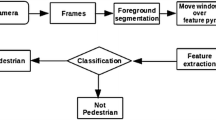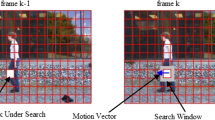Abstract
The paper proposes a motion-based technique to detect persons in a low-resolution video, where the persons look like tiny blobs. The tiny blob-like appearance of the persons are due to camera position which is at a distance from the person(s). The proposed technique uses integral matrix based different spatial and temporal features. Gradient weighted optical flow (GWOF) is calculated for each frame of the video clip to minimize background noise. Spatial filters are used to extract motion features from the GWOF based integral matrices. The combination of image gradient and GWOF features extracts static and moving persons present in the video. The AdaBoost learning technique is used for training. The training is performed using features derived from the positive samples of bounding boxes in a video frame containing a person and negative samples with bounding boxes without a person. The proposed technique is applied on benchmark Tower dataset, UT-Interaction dataset and PETS 2007 dataset. We have obtained approximately 2 to 10 % improvement in the performance compared to the states-of-the-art.









Similar content being viewed by others
References
Breitenstein M D, Reichlin F, Leibe B, Koller-Meier E, Van Gool L (2011) Online multiperson tracking-by-detection from a single, uncalibrated camera. IEEE Trans PAMI 33 (9):1820–1833
Chen C-C, Ryoo M S, Aggarwal J K (2010) UT-tower dataset: aerial view activity classification challenge. http://cvrc.ece.utexas.edu/SDHA2010/Aerial_View_Activity.html. January, (2010, accessed as on May, 2012)
Dalal N, Triggs B (2005) Histograms of oriented gradients for human detection. In: IEEE CVPR, pp 886–893
Ferrari V, Fevrier L, Jurie F, Schmid C (2008) Groups of adjacent contour segments for object detection. IEEE Trans PAMI 30 (1):36–51
Freund Y, Schapire R E (1999) A short introduction to boosting. J Jpn Soc Artif Intell 14 (5):771–780
Lee K-D, Mi Y N, Chung K-Y, Lee Y-H, Kang U-G (2013) Context and profile based cascade classifier for efficient people detection and safety care system. Multimedia Tools Appl 63 (1):27–44
Lu W-L, Ting J-A, Murphy K P, Little J J (2011) Identifying players in broadcast sports videos using conditional random fields. In: IEEE CVPR, pp 3249–3256
Mittal A, Paragios N (2004) Motion-based background subtraction using adaptive kernel density estimation. In: IEEE CVPR, vol 2. pp II-302–II-309
Munaro M, Cenedese A (2011) Scene specific people detection by simple human interaction. In: IEEE ICCV Workshop, pp 1250–1255
Mukherjee S, Biswas S K, Mukherjee D P (2011) Recognizing human action at a distance in video by key poses. IEEE Trans CSVT 21 (9):1228–1241
Nguyen D T, Ogunbona P O, Li W (2013) A novel shape-based non-redundant local binary pattern descriptor for object detection. Pattern Recognit 46:1485–1500
Ott P, Everingham M (2009) Implicit color segmentation features for pedestrian and object detection. In: IEEE ICCV
Ogale N A (2006) A survey of techniques for human detection from video, Survey, University of Maryland
Parag T, Elgammal A, Mittal A (2006) A framework for feature selection for background subtraction. In: IEEE CVPR, pp 1916–1923
Pai C-J, Tyan H-R, Liang Y-M, Liao H-Y M, Chen S-W (2004) Pedestrian detection and tracking at crossroads. Pattern Recognit 37 (5):1025–1034
Ryoo M S, Aggarwal J K (2010) UT-interaction dataset, ICPR contest on semantic description of human activities (SDHA). http://cvrc.ece.utexas.edu/SDHA2010/Human_Interaction.html (2010, accessed as on May, 2012)
Sidenbladh H (2004) Detecting human motion with support vector machines. In: IEEE ICPR, vol 2. pp 188–191
Viola P, Jones M J (2004) Robust real-time face detection. Int J Comput Vis 57 (2):137–154
Viola P, Jones M J, Snow D (2005) Detecting pedestrians using patterns of motion and appearance. Int J Comput Vis 63 (2):153–161
Author information
Authors and Affiliations
Corresponding author
Rights and permissions
About this article
Cite this article
Mukherjee, S., Mukherjee, D.P. A motion-based approach to detect persons in low-resolution video. Multimed Tools Appl 74, 9475–9490 (2015). https://doi.org/10.1007/s11042-014-2128-6
Received:
Revised:
Accepted:
Published:
Issue Date:
DOI: https://doi.org/10.1007/s11042-014-2128-6




